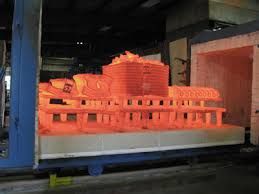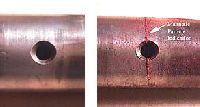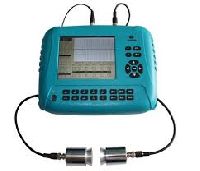
Stress Relieving Furnaces
We have carried out ISR & LSR of -20 temperature at China by Internal Oil Firing in Furnace. We have performed PWHT of assembly having -20 temperature at China. Year 2010-2011, we have carried out LSR & ISR of 126 cs of 4.5 diameter x 290mm thk (Cr-Mo V material by hybrid method i.e. with combination of gas firing and electrical resistance method. Year 2010-2011, itself we have carried out more than 250 charges of various job in various Furnaces by natural gas.
...more
normalizing furnace
Normalizing is the process of raising the temperature to over 60 ° C (108 °F), above line A3 or line ACM fully into the Austenite range. It is held at this temperature to fully convert the structure into Austenite, and then removed form the heating zone and cooled at room temperature under natural convection. This results in a grain structure of fine Pearlite with excess of Ferrite or Cementite. The resulting material is soft; the degree of softness depends on the actual ambient conditions of cooling. This process is considerably cheaper than full annealing since there is not the added cost of controlled cooling. The main difference between full annealing and normalizing is that fully annealed parts are uniform in softness (and machine ability) throughout the entire part; since the entire part is exposed to the controlled furnace cooling. In the case of the normalized part, depending on the part geometry, the cooling is non-uniform resulting in non-uniform material properties across the part. This may not be desirable if further machining is desired, since it makes the machining job somewhat unpredictable. In such a case it is better to do full annealing.
...more
normalizing
Normalizing is the process of raising the temperature to over 60 ° C (108 °F), above line A3 or line ACM fully into the Austenite range. It is held at this temperature to fully convert the structure into Austenite, and then removed form the heating zone and cooled at room temperature under natural convection. This results in a grain structure of fine Pearlite with excess of Ferrite or Cementite. The resulting material is soft; the degree of softness depends on the actual ambient conditions of cooling. This process is considerably cheaper than full annealing since there is not the added cost of controlled cooling.
...more
magnetic yoke
This NDE method is accomplished by inducing a magnetic field in a ferromagnetic material and then dusting the surface with iron particles (either dry or suspended in liquid). Surface and near-surface flaws produce magnetic poles or distort the magnetic field in such a way that the iron particles are attracted and concentrated. This produces a visible indication of defect on the surface of the material. The images below demonstrate a component before and after inspection using dry magnetic particles. We are conducting dry wet, visible fluorescent magnetic particle examination by yokeprod method for materials and weld joints during fabrications and in service for wide range of industries like steel plant, cement mills, nuclear power plant, petrochemical and fabrication shops.
...more
electromagnetic yoke
This NDE method is accomplished by inducing a magnetic field in a ferromagnetic material and then dusting the surface with iron particles (either dry or suspended in liquid). Surface and near-surface flaws produce magnetic poles or distort the magnetic field in such a way that the iron particles are attracted and concentrated. This produces a visible indication of defect on the surface of the material. The images below demonstrate a component before and after inspection using dry magnetic particles. We are conducting dry wet, visible fluorescent magnetic particle examination by yokeprod method for materials and weld joints during fabrications and in service for wide range of industries like steel plant, cement mills, nuclear power plant, petrochemical and fabrication shops.
...more
Eddy Current Testing Equipment
Eddy currents are created through a process called electromagnetic induction. When alternating current is applied to the conductor, such as copper wire, a magnetic field develops in and around the conductor. This magnetic field expands as the alternating current rises to maximum and collapses as the current is reduced to zero. If another electrical conductor is brought into the close proximity to this changing magnetic field, current will be induced in this second conductor. Eddy currents are induced electrical currents that flow in a circular path. They get their name from "eddies" that are formed when a liquid or gas flows in a circular path around obstacles when conditions are right.
...more
Dye Penetrant Inspection Kit
Penetrant solution is applied to the surface of a precleaned component. The liquid is pulled into surface-breaking defects by capillary action. Excess penetrant material is carefully cleaned from the surface. A developer is applied to pull the trapped penetrant back to the surface where it is spread out and forms an indication. The indication is much easier to see than the actual defect.
...more
Ultrasonic Testing
High frequency sound waves are sent into a material by use of a transducer. The sound waves travel through the material and are received by the same transducer or a second transducer. The amount of energy transmitted or received and the time the energy is received are analyzed to determine the presence of flaws. Changes in material thickness, and changes in material properties can also be measured. Used to locate surface and subsurface defects in many materials including metals, plastics, and wood. Ultrasonic inspection is also used to measure the thickness of materials and otherwise characterize properties of material based on sound velocity and attenuation measurements.
...moreBe first to Rate
Rate This